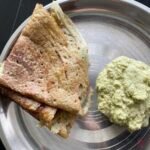Moong Beans Dosa (Pancake) | Pesarattu with Coconut and Curry Leaves Chutney
Pesarattu as it is called in India is a protein packed delicious and highly nutritious pancake made form whole mung beans. Have it with coconut curry leaves chutney to make a complete meal and ideal breakfast. Great for kids, Diabetics, PCOS, pregnancy and for all who enjoy healthy breakfast.
Servings: 4 people
Cost: $10
Equipment
- Grinder or Food Processor for Coconut Chutney
- Broad and Shallow Pan or Tawa to make pancake
- Ladle to make pancake
- Sharp Spatula for the pancake
Ingredients
For Coconut Curry Leaves Chutney
- 200 g Fresh Coconut With Peel or without peel
- 2-3 Sprigs Curry Leaves
- 1 inch Fresh ginger root optional
- 1 small green chili optional
- 1 tsp Rock Salt To taste
- ½ tsp Roasted Cumin Powder optional
- 1 tsp Dried onion powder optional
- ½ Cup Water To make chutney
For Moon Beans Dosa
- 1 cup Whole Mung Beans About 200 g
- 2-3 sprigs Fresh curry leaves
- 1 inch Fresh Ginger Root Pound or grated or replace with dry ginger powder (1 tsp)
- 1½ tsp Salt to taste
- 1 tsp Roasted Cumin Seeds powder
- 1½ cups Water Make sure that the mix is consistent and flowing. Change amount of water to your requirement.
- 3 tbsp Ghee or Coconut Oil To make the Dosa
Instructions
Preparing the Coconut Chutney
- Cut the fresh coconut into small pieces.
- Peel the ginger and cut in small pieces.
- Wash and separate the curry leaves and keep aside.
- Add all the ingredients to the grinder along with water.
- Grind till it makes a smooth chutney mix.
Making Pesarattu Batter
- Add mung beans to a large bowl and wash well.
- Soak in water for 4-6 hours. Keep water height around ½ inch above the mung beans.
- Now add the mung beans, ginger, salt, curry leaves and a little water to the grinder. Mix well to make a runny and consistent batter.
- The batter should be of pouring consistency, yet thick and spreadable to make the pancakes.
Making the Dosa
- Heat a pan on medium flame. Spread some ghee on the pan.
- Once the pan is medium to hot, it is ready to make the dosa. Check by splashing a few drops of water on the pan. It will quickly steam off.
- Pour ½ to ¾ of ladle batter on the pan. Then quickly spread it into a thin layer starting from the centre and moving towards the edges of the pan.
- Let the base cook and become crisp. Sprinkle some ghee on top. Sprinkle a few drops of ghee on the sides of the dosa as well.
- When the base is golden and crisp, turn over and cook the other side (for few seconds). You may or may not need to cook the other side, depending on the thickness of your batter.
- Serve the Dosa with the coconut chutney. Enjoy!

Notes
For the Pesarattu
- Consistency of the batter is the key. Make sure that the batter is thick yet spreading such that you are able to easily make the dosa.
- If the batter is too thin, then you can thicken it up with some ragi (finger millet flour) or any other flour of your choice.
- If it is too thick and hard to spread, then add some water to the grinder in the mixer itself. Directly adding water to the batter makes it difficult to make the dosa (they become too sticky).
- Higher soaking time makes a softer dosa. If you enjoy crispy and crunchy pesarattu, then keep soaking time to 4-6 hours only.
- More soaking will lead to sprouting of beans, which increases the health quotient of the dosa. So, you can try both ways and see which one you like more.
For the Coconut Chutney
- You can make the chutney with desiccated coconut too. However, the taste of freshly grated coconut is creamier, fresher and so much more nicer.
- Add the herbs of your choice. We added ginger and curry leaves. You can add onion powder, chili, and replace curry leaves with coriander leaves or others that are available to you.
